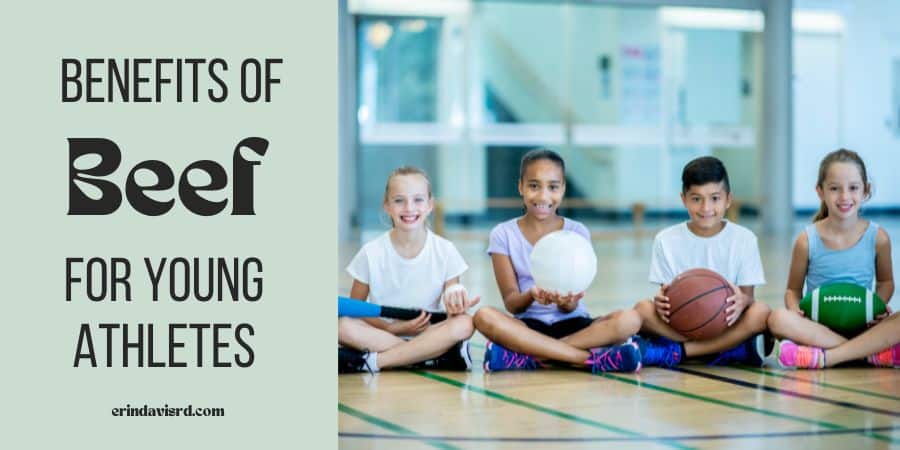This post is a collaboration with National Cattlemen’s Beef Association, on behalf of the Beef Checkoff. I received compensation, but all opinions are my own.
Summer is coming to an end, and that means that fall sports season is ramping up.
For us, the back-to-school season includes a steady schedule of football and volleyball. Besides getting my three kids (ages 16, 13, and 11) to their various practices and games on time, I am also aware of the important ways in which I can help meet their nutrition needs.
These adolescent years are a crucial time to get proper nutrition to support all the growth and development occurring. Yet nutrient deficiencies are surprisingly common during this stage of life.1
My growing athletes require good nutrition. Each of my children wants to perform their best, both on and off the field, and I need to ensure they eat the nutrients their bodies need.
I can’t just rely on concession stand soft pretzels to provide the nutrients needed for their growth, development, sports and academic performance. Luckily, we have an excellent source of vitamins, minerals, and protein always on hand.
As hobby farmers, we have raised beef (black/red Angus and Herefords) for six years. We’ve figured out a system to have our freezer fully stocked. And, a major bonus is that many of my go-to beef recipes come together quickly! (Check out my post on Meal Planning for Busy Moms)
Adolescent and teen athletes need iron, zinc, choline, B vitamins, and phosphorus for good health and optimal performance. Beef delivers all the above. On top of that, it’s a versatile, high-quality protein my whole family enjoys. In today’s post, I’m reviewing the benefits of beef for young athletes.
High-Quality Protein for Young Athletes
Protein is essential for the growth and repair of every cell in the body. You need protein to build lean muscle, heal a cut, and produce essential hormones to maintain optimal health. As you can imagine, protein is especially important as your child is growing.
Then consider the regular physical activity that occurs with sports. Whether your child is in gymnastics, swimming, or baseball, each repetition aims to build a particular skill and strength.
There may be an increased need2 for protein when you are physically active. So, if your kiddo is like mine and doing some sort of sport nearly every day, protein should be a priority.
Protein throughout the day is important, but especially after3 physical activity to support recovery. I like to have simple meals or snacks prepped for after practice or games, like a quick Ground Beef meal or crockpot beef recipes.
Beef is a complete, high-quality protein food that contains all the essential amino acids
the body needs to support physical activity.
The Importance of Iron for Young Athletes
Next is iron. Iron is important for growth, development, cell function, and the production of some hormones. Its main role is to carry oxygen throughout the body.
Oxygen transport is a big deal when you are an athlete. Any time you run or perform an activity that requires your muscles, you want them to have plenty of oxygen. Therefore, adequate iron is key for any sport.
Unfortunately, iron deficiency is common4 among athletes, especially females5. If you’re running low on iron, your performance is going to be affected. Iron improves muscle endurance and increases energy, so low iron levels oftentimes leave an athlete feeling sluggish. Every workout will feel hard.
Ensuring your athletes get enough iron will likely avoid deficiency and keep them running at top-notch.
There are two types of dietary iron— nonheme and heme. The primary difference between the two types is how much the body can absorb of each.
Nonheme iron is found in plant sources and iron-fortified foods. You absorb6 around 2-9% of iron coming from veggies, legumes, or grains.
On the other hand, heme iron, which is found in animal-based foods, is more readily absorbed—up to 30%. For that reason, heme iron food sources, like beef, may help prevent iron deficiency in your young athlete.
The iron in beef is more easily absorbed, so may also more easily help prevent fatigue. That means there’s energy left for homework…and chores. No excuses!
Why Kids Need Zinc
Zinc is another essential mineral that plays a role in your young athletes’ sports performance. Not only is zinc involved in hormone regulation that impacts muscle growth and recovery, but it helps improve aerobic capacity.
In other words, adequate zinc is important for training and recovery. It’s also been linked with sleep quality.
Another reason to focus on zinc is that it is a key player in immune system support.
We all know that the back-to-school season means more germs. A lot more germs. It’s inevitable. They share close quarters, and maybe even water bottles. You want your child’s immune system working at full capacity.
Sickness puts a huge damper on training. Zinc deficiency may limit immune function and could also impair brain function and development by affecting attention, activity, and motor development.
The foods richest in zinc are fish, seafood, and meat like beef. Beef is responsible for 20%7 of zinc intake in the U.S.
Choline for Brain Support
Choline is a nutrient we don’t hear much about, but that doesn’t mean it isn’t important for your growing athlete.
Your body needs choline for brain and nervous system function. It helps regulate memory and mood, as well as muscle control.
So not only is choline aiding in your child’s school performance, but it’s also enhancing their ability to play their chosen sport. From learning how to reduce fractions to improving a basketball shot, choline is an essential for the back-to-school season.
The good news is that choline is found in a number of foods, and beef is an excellent source.
B Vitamins for Energy and Healthy Cells
The back-to-school season requires plenty of energy (for both your kids and you)! As you adjust to new schedules, studying, and sporting events, you’ll all need optimal energy levels.
That’s where Vitamin B6, or pyridoxine, comes in. Vitamin B6 plays a pivotal role in energy metabolism. Simply put, Vitamin B6 turns stored glucose into useable energy.
Any time your child eats, their body goes through the process of turning food into energy. The body stores what isn’t immediately used. Then, when your child’s body needs fuel (like during an after-school practice), it uses Vitamin B6 to produce energy for movement and other processes.
It’s no surprise then that athletes with low Vitamin B6 intakes often report8 lower energy levels. All the more reason to eat a balanced diet.
Beef is a good source of Vitamin B6. In fact, in a 3 oz serving of Lean Ground Beef, there 0.4 mg of Vitamin B6—almost half of the daily recommendation for an adolescent.
Furthermore, there’s another B vitamin I want to hone in on. Vitamin B12.
Also known as cobalamin, Vitamin B12 aids in red blood cell production, healthy cell development, and nervous system function. If you think those are key for a growing athlete, you’re right!
It’s easy to hit the recommended amount of Vitamin B12 with a simple meal. A 3 oz Lean Ground Beef patty contains enough vitamin B12 for kids 4-13 years. Kids 14 and older need a bit more, but that burger helps them come close!
Phosphorus for Energy Production
Lastly, a young athlete needs adequate phosphorus. Phosphorus is an essential mineral that is a major building block of bones and teeth.
Of course, every child needs strong bones and teeth. But for your sports star, adequate phosphorus is also essential for every practice and game.
Phosphorus is a prime component in the body’s energy source, adenosine triphosphate (ATP).
Pretty much every movement we make requires energy in the form of ATP9. It’s stored energy that gets broken down as your child plays ANY sport.
Fortunately, it’s easy for your child to get phosphorus from their diet. It’s readily found in foods like dairy products, fish, nuts, and beef.
Bottomline on Beef for Youth Athletes
At the end of a busy day, it’s important I feel confident that my kids are getting the nutrition they need from their diet.
Beef, as part of balanced meals containing nutrient-dense foods like whole grains, vegetables, fruits, nuts, and seeds, is an excellent way to get the nutrients their growing and active bodies need.
Not only does it contain many of the nutrients your child requires, but beef is easy to cook when you are pressed for time.
Be sure to visit the Beef for Tweens and Teens or the 30 Minutes or Less Collection for recipe inspiration!
References
- Hudson JL, Baum JI, Diaz EC, Børsheim E. Dietary Protein Requirements in Children: Methods for Consideration. Nutrients. 2021;13(5):1554. Published 2021 May 5. doi:10.3390/nu13051554
- Moore DR, Volterman KA, Obeid J, Offord EA, Timmons BW. Postexercise protein ingestion increases whole body net protein balance in healthy children. J Appl Physiol (1985). 2014;117(12):1493-1501. doi:10.1152/japplphysiol.00224.2014
- Clénin G, Cordes M, Huber A, et al. Iron deficiency in sports – definition, influence on performance and therapy. Swiss Med Wkly. 2015;145:w14196. Published 2015 Oct 29. doi:10.4414/smw.2015.14196
- DellaValle DM. Iron supplementation for female athletes: effects on iron status and performance outcomes [published correction appears in Curr Sports Med Rep. 2013 Sep-Oct;12(5):349]. Curr Sports Med Rep. 2013;12(4):234-239. doi:10.1249/JSR.0b013e31829a6f6b
- Piskin E, Cianciosi D, Gulec S, Tomas M, Capanoglu E. Iron Absorption: Factors, Limitations, and Improvement Methods. ACS Omega. 2022;7(24):20441-20456. Published 2022 Jun 10. doi:10.1021/acsomega.2c01833
- Huth PJ, Fulgoni VL, Keast DR, Park K, Auestad N. Major food sources of calories, added sugars, and saturated fat and their contribution to essential nutrient intakes in the U.S. diet: data from the National Health and Nutrition Examination Survey (2003-2006). Nutr J. 2013;12:116. Published 2013 Aug 8. doi:10.1186/1475-2891-12-116
- Institute of Medicine (US) Standing Committee on the Scientific Evaluation of Dietary Reference Intakes and its Panel on Folate, Other B Vitamins, and Choline. Dietary Reference Intakes for Thiamin, Riboflavin, Niacin, Vitamin B6, Folate, Vitamin B12, Pantothenic Acid, Biotin, and Choline. Washington (DC): National Academies Press (US); 1998. Available from: https://www.ncbi.nlm.nih.gov/books/NBK114310/ doi: 10.17226/6015
- Manore MM. Vitamin B6 and exercise. Int J Sport Nutr. 1994;4(2):89-103. doi:10.1123/ijsn.4.2.89
- Dunn J, Grider MH. Physiology, Adenosine Triphosphate. [Updated 2023 Feb 13]. In: StatPearls [Internet]. Treasure Island (FL): StatPearls Publishing; 2024 Jan-. Available from: https://www.ncbi.nlm.nih.gov/books/NBK553175/
Other posts you may like:
- Softball and Baseball Mom Bag Essentials and Snacks
- Types of Hunger
- 10 Ways to Manage Gestational Diabetes
- What to Make for a Potluck
- Self Care Routines for Busy Moms
About the author
Erin is a registered dietitian and diabetes educator with almost 20 years of experience. She specializes in weight-inclusive diabetes care and prevention, intuitive eating, fitness, and women’s health. She works as a consultant and writer in the health and wellness space. Erin is passionate about empowering people to manage their own health and to have peace with food.


